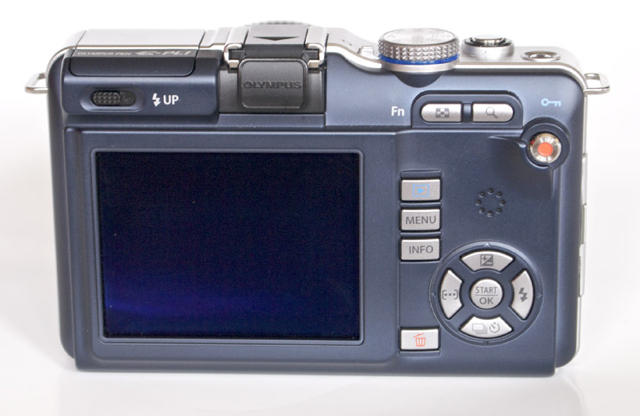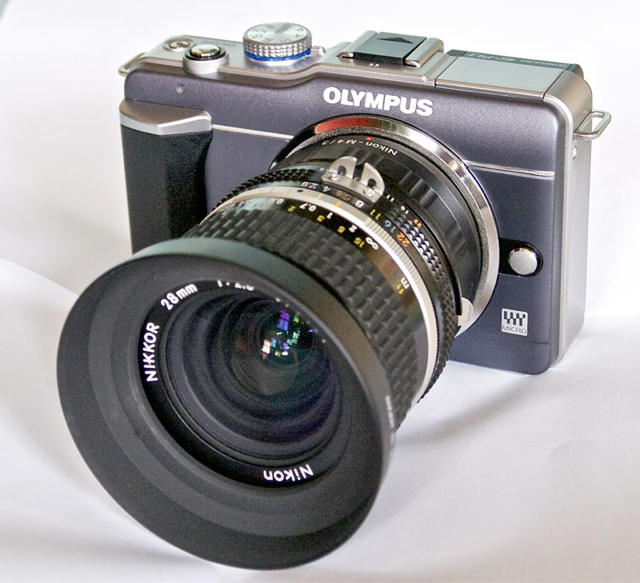Just point and shoot as fast as possible, or you might miss the moment. This is the mantra of most digital camera owners. Set the camera on auto exposure, auto focus, auto everything – and expect the camera to figure everything out instantly and also provide you with museum quality photos. All this expectation and I want it to fit in my shirt pocket.
It is what American consumers have grown to expect. If, on the other hand, you want a choice of interchangeable lenses, manual control and professional results you have to spend an arm and a leg for one of the many pro SLR cameras on the market. Do you want to spend $1,300 and up on a body and another $500 or more for a decent lens? How about the bulk and weight of a pro system? Who wants to carry all that stuff around? Trust me, it won’t fit in your pocket.
Enter the new Olympus PEN E-PL1 interchangeable lens micro 4/3. Retailing for about $525 (MSRP is $599), the E-PL1 has a 4/3 inch 12.3-megapixel high-speed Live MOS sensor and TruePic V image-processing engine; this little camera can also do 720p HD videos. It has built-in image stabilization (IS), a Live Guide user interface, HDMI output, ISO sensitivity ranges from 100 to 3200, TTL-AUTO and Super FP flash, and wireless remote control flash. It may not fit in your pocket, but you won’t need a pack of horses to transport it.

What the heck is 4/3 anyway? Olympus and Kodak developed this open format from scratch as if 35mm film never existed. Panasonic and Olympus are the first to manufacture 4/3 cameras and lenses. Micro 4/3 lenses have the same multiplier as regular 4/3 (X2) but the lens sits closer to the sensor and provides for smaller form factors; hence the term MICRO. The list of available micro 4/3 lenses is growing; Olympus just released two more lenses.
Shooting with the E-PL1
There are eight shooting modes. iAUTO: Full auto, P: Program, A: Aperture priority, S: Shutter priority, M: Manual, ART: Art filter and SCN: Scene. Oh, yeah Movie too. For this mode Olympus gives you a dedicated movie button on the back of the camera (a red button), which allows you to shoot 720P HD on the fly.
Lets talk about the lesser-known modes for a little. iAUTO – A full auto mode in which the camera automatically optimizes settings for the current scene. It comes with “live guide,” literally, a live guide to creative adjustments that includes pointers on how to shoot different types of photos. As you adjust the different parameters you can see how it will affect the final photo “live.”
ART – As the name implies, you select from six art filters that range from cool to gimmicky: Pop Art, Soft Focus, Grainy B&W, Pin Hole, Diorama and Sepia. Too bad you can only select one at a time.
SCN – Has nineteen scene modes: from Portrait and Fireworks to Children and Beach & Snow. It includes Panorama, which allows you to take up to ten shots and later stitch them together as a panorama with the supplied Olympus software.

Old Lenses, New Life
As of this writing, Olympus has four new micro 4/3 lenses: 9-18mm, 14-150mm, 17mm and 14-42mm. One of my favorite things about this camera is the fact that you can get lens adapters and use old manual focus lenses. Have you got some old Nikon lenses sitting around? I do! I have what Ken Rockwell claims is the sharpest wide-angle lens Nikon ever made, take a look – say it with me: cool!

Flash for the Rest of Us
Would you like the ability to control up to three flash units – remotely? How about each one independently? Wait for it… Yeah! I didn’t test this feature but I like what it can do. You can set-up some pretty complicated lighting without wires.

Conclusions
The E-PL1 is smaller, lighter and less expensive than the older E-P1. It comes with a built-in flash able to wirelessly control up to three external flash units. It comes with Live Guide control and an external mic connector. You get ART filters and scene choices. Total manual controls or you can set it on iAUTO and let the camera think for you. You can shoot 720P HD video. Did I mention you could use ART filters on movies?
You want to go into the garage and look for all your old Nikon lenses? They’ll work with an m4/3 lens adapter. OK, it won’t fit in your pocket, but with all the choices you get, I don’t want to hear anybody complaining.
OK, just a little complaint – My only beef is that there’s not enough dials to make adjustments easier; you have to dig into the menus with buttons. It’s almost there. It’s not ready for pros, but for serious amateurs, the E-PL1 is just shy of perfect.
Sample Photos:



![Olympus PEN E-PL1 Camera Is Almost Perfect [Review] e-pl1-hand](https://www.cultofmac.com/wp-content/uploads/2010/06/e-pl1-hand1.jpg)

